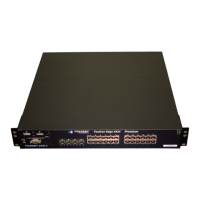Configuring Virtual LANs (VLANs)
December 2005 © Foundry Networks, Inc. 11 - 35
FastIron SuperX Router(config-vlan-10)# dynamic
FastIron SuperX Router(config)# write memory
These commands create a port-based VLAN on chassis ports 2/1 – 2/6 named “Eng-LAN”, configure an IPX
network VLAN within the port-based VLAN, and then add ports from the port-based VLAN dynamically.
Syntax: vlan <vlan-id> by port [name <string>]
Syntax: untagged ethernet [<slotnum>/]<portnum> to [<slotnum>/]<portnum>
Or
Syntax: untagged ethernet [<slotnum>/]<portnum> ethernet [<slotnum>/]<portnum>
NOTE: Use the first untagged command for adding a range of ports. Use the second command for adding
separate ports (not in a range).
Syntax: ipx-network <network-addr> ethernet_ii | ethernet_802.2 | ethernet_802.3 | ethernet_snap
[name <string>]
Syntax: dynamic
Configuring Uplink Ports Within a Port-Based VLAN
You can configure a subset of the ports in a port-based VLAN as uplink ports. When you configure uplink ports in
a port-based VLAN, the device sends all broadcast and unknown-unicast traffic from a port in the VLAN to the
uplink ports, but not to other ports within the VLAN. Thus, the uplink ports provide tighter broadcast control within
the VLAN.
For example, if two ports within a port-based VLAN are Gigabit ports attached to the network and the other ports
in the VLAN are 10/100 ports attached to clients, you can configure the two ports attached to the network as uplink
ports. In this configuration, broadcast and unknown-unicast traffic in the VLAN does not go to all ports in the
VLAN. The traffic goes only to the uplink ports. The clients on the network do not receive broadcast and
unknown-unicast traffic from other ports, including other clients.
To configure a port-based VLAN containing uplink ports, enter commands such as the following:
FastIron SuperX Router(config)# vlan 10 by port
FastIron SuperX Router(config-vlan-10)# untag ethernet 1/1 to 1/24
FastIron SuperX Router(config-vlan-10)# untag ethernet 2/1 to 2/2
FastIron SuperX Router(config-vlan-10)# uplink-switch ethernet 2/1 to 2/2
Syntax: [no] uplink-switch ethernet [<slotnum>/]<portnum> [to [<slotnum>/]<portnum> | ethernet [<slotnum>/
]<portnum>]
In this example, 24 ports on a 10/100 module and two Gigabit ports on a Gigabit module are added to port-based
VLAN 10. The two Gigabit ports are then configured as uplink ports.
Configuring the Same IP Sub-Net Address on Multiple Port-Based
VLANs
For a Foundry device to route between port-based VLANs, you must add a virtual routing interface to each VLAN.
Generally, you also configure a unique IP sub-net address on each virtual routing interface. For example, if you
have three port-based VLANs, you add a virtual routing interface to each VLAN, then add a separate IP sub-net
address to each virtual routing interface. The IP address on each of the virtual routing interfaces must be in a
separate sub-net. The Foundry device routes Layer 3 traffic between the sub-nets using the sub-net addresses.
NOTE: This feature applies only to Layer 3 Switches.

